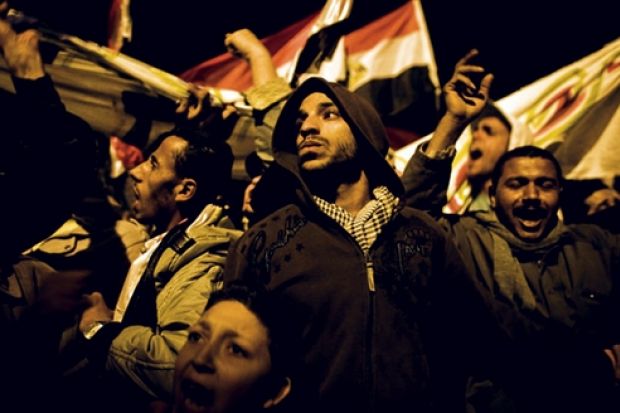To reach the heart of the Arab Spring, Guy Martin set out from a job teaching photography at University College Falmouth, joined surging Cairo crowds to document the Egyptian revolution for The Wall Street Journal, took a 40-hour boat trip into the battle between Libyan rebels and the Gaddafi regime - then ended up on an operating table after losing half his intestines in a mortar blast.
After surviving the attack in Misrata in which a documentarist and another photographer were killed, Mr Martin is putting on an exhibition of his dramatic work from the Middle East.
He has long combined teaching at Falmouth with projects in places such as Sudan and the Kurdish areas between Turkey and Iraq. At the beginning of last year, he was planning to go to Azerbaijan. But then he "started reading about what was happening in Tunisia. It caught a lot of us by surprise. The more I read, the more I felt connected to it - a largely bloodless revolution being made by people of my own age using social media."
Flak jacket at the ready
Keen to witness the next stage of the unfolding Arab Spring, Mr Martin flew out to Egypt on 26 January, secured work with The Wall Street Journal for three and a half weeks and decided to stay on for an extra week because "the story hadn't ended with the daily news cycle".
After a brief interlude in Norway on a music assignment, he returned to the Middle East as "Libya was kicking off and attention shifted there when Nato got involved".
Although unsympathetic to the machismo and adrenalin addiction of professional war photographers, Mr Martin is fascinated by "people and countries going through transition - though in Libya they happened to be armed".
He had had a scare in Egypt when "we were stopped by the army going out into the desert, our cameras were confiscated and we were threatened with execution, until our driver/fixer intervened". For Libya, he made sure he had a flak jacket and helmet.
At first, Mr Martin was based in Benghazi, "following the rebels into the desert", but he soon began to feel that he was repeating himself. So he set off for the besieged city of Misrata, reachable only by a 40-hour boat journey, where rebels were engaged in desperate house-to-house fighting along Tripoli Street.
On 20 April, Mr Martin and his colleagues were following the rebel forces, who seemed to have made a significant breakthrough. Everything "felt very eerie and calm". Suddenly, despite intelligence claims that the area had been cleared, a mortar fired by Gaddafi loyalists three miles away landed only feet from them.
This was the blast that killed the US photographer Chris Hondros and the British documentarist Tim Hetherington, co-director of Restrepo, which won the Grand Jury Prize at the Sundance Film Festival. Mr Martin has often been told he was lucky to survive.
When he woke up in hospital about 24 hours later, he learned that he had shrapnel injuries to his pelvis and that he had lost almost half his intestines. A volunteer Egyptian vascular surgeon had contained the blood loss and fitted an artificial vein.
After a week in Misrata, with the fighting growing ever more ferocious, Mr Martin was evacuated through stormy seas to Malta on a tiny cargo ship. He then spent a week in intensive care and was eventually flown back to Cornwall. There, he spent several more weeks in hospital before contracting a virus and being taken in a wheelchair to his parental home.
Snap view
Mr Martin's experiences have left him with a permanent legacy, most notably in the two large pieces of shrapnel embedded in his body. But he was approached by Falmouth to return to his teaching work and put together an exhibition of 45 powerful photographs from his time in Egypt and Libya.
Titled Shifting Sands, it forms the focus of a series of events running at the university, including a public conversation with Mr Martin, from 10 to 14 January.
